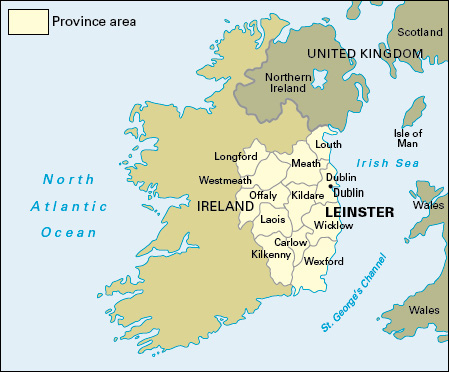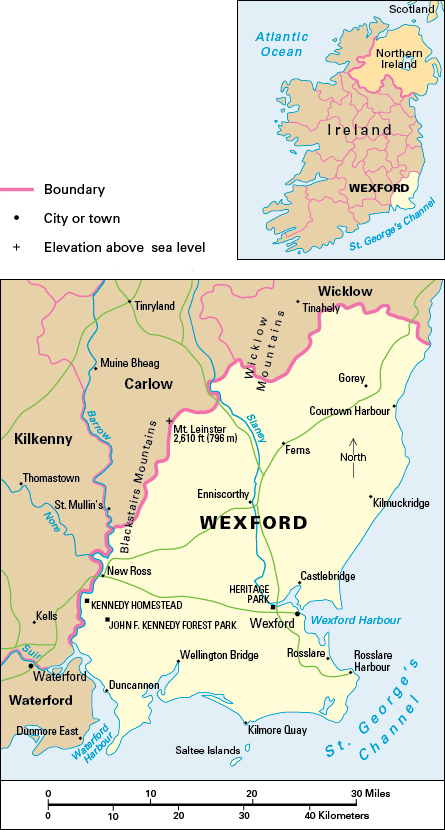Wexford, County, lies in the province of Leinster in Ireland, also called the Republic of Ireland. It covers an area of 908 square miles (2,351 square kilometers) along Ireland’s southeast coast. Because of the good quality of its farming, County Wexford is sometimes called the model county. The county’s largest town and service center is the town of Wexford.

Most of the people of County Wexford are Roman Catholic. Many of the rest belong to the Church of Ireland or claim no religious affiliation.
Economy.
Much of the land in County Wexford is fertile, except in the mountains and along parts of the east and south coast. The county’s main crops include barley, fruit, oats, potatoes, and wheat. Beef cattle and dairy cows are the major livestock. Some farmers keep sheep, especially in the uplands, and there is some horse breeding. Hog production is also an important activity.

Engineering and food-and-beverage processing are major manufacturing activities in County Wexford. Agricultural machinery is a traditional product, but most of the engineering is now of other types. The food industries process fish, fruit, grain, meat, milk, and mushrooms. There are also bakery and soft-drink industries. Other industries in the county produce medical devices, personal care products, and transportation equipment. The construction industry also employs many workers.
Service industries are by far the leading source of employment in County Wexford. Important service industries include education, food services and hotels, health care and social work, professional services, transportation, and wholesale and retail distribution.
Tourism is important to the county’s economy. The county’s beaches and relatively sunny climate are major attractions. Many people from Dublin own second homes along the coast of County Wexford. Courtown Harbour and Rosslare are seaside resorts. The John F. Kennedy Arboretum lies south of New Ross, near the former United States president’s ancestral home at Dunganstown. The Irish National Heritage Park, near the town of Wexford, features reconstructed sites that show how people lived during different historical periods.
The fishing industry is important along County Wexford’s coast. Kilmore Quay is the leading port and has fish-processing industries. Boats also land fish at Rosslare and Duncannon. There is mussel farming in Wexford Harbour. The seaport at Rosslare Harbour handles large amounts of international passenger and freight traffic. It serves several sea routes between Ireland and the United Kingdom and mainland Europe.
Land.
The Irish Sea and St. George’s Channel form County Wexford’s boundaries on the east and south. Counties Waterford, Kilkenny, and Carlow lie to the west, and County Wicklow to the north.
Much of the western boundary with County Carlow runs along the Blackstairs Mountains, part of the Leinster Chain. The highest point is Mount Leinster, at 2,610 feet (796 meters) above sea level. The mountains are granite and run northeast to southwest. An upland area extends from County Wicklow into the northern part of County Wexford.
Much of County Wexford is rolling lowland between the mountains and the sea. The county lies mainly on slate and shale, some of the rocks being among the most ancient in Ireland.
The River Slaney drains most of the county. It is the only river to cut through the Leinster Chain. Beyond the mountains, it flows south across the lowland into Wexford Harbour. The River Barrow forms the western boundary with County Kilkenny and enters the long inlet of Waterford Harbour. Stretches of sandy beach, sand dunes, and sand bars fringe the coast. Some land has been reclaimed from the sea around Wexford Harbour. The Saltee Islands, off the south coast, are a bird sanctuary.
History.
Evidence shows that what is now County Wexford has been inhabited since Stone Age times. The Vikings established the town of Wexford as a trading center in the A.D. 800’s. However, the impact of the Anglo-Normans on County Wexford and on Ireland was much greater than that of the Vikings.
The Anglo-Normans first landed on the south coast of Wexford in 1169. Dermot MacMurrough, ruler of the local kingdom of Hy Kinsella and king of Leinster, had sought help from Flemish, Norman, and Welsh soldiers in an internal conflict. The MacMurrough seat was at Ferns, which was the site of a Celtic monastery. Ferns became an important medieval town after the arrival of the Anglo-Normans. Other towns that expanded under the Anglo-Normans included Enniscorthy, New Ross, and Wexford.
During the early 1600’s, the British government gave lands in the county to English settlers and those loyal to England. The town of Wexford played an important role in the Irish rebellion of the 1640’s. In 1649, following the rebellion, the English leader Oliver Cromwell plundered the town. County Wexford was the focus of the United Irishmen rebellion of 1798 against the British. Following initial successes, the rebellion ended in failure with the Battle of Vinegar Hill at Enniscorthy.
In the late 1840’s, during the Great Irish Famine, County Wexford lost one-tenth of its population through death and emigration. Its loss was less than that of other counties, except for County Dublin.
See also Ireland, History of (The Normans in Ireland (1100’s-1400’s); The Rebellion of 1641 and the Cromwellian settlement).
